
In musical practice uses a large number of diverse musical modes. Of these, two frets are the most common and practically universal: this is a major and a minor. So, both major and minor are of three types: natural, harmonic and melodic. Just do not be afraid of it, everything is simple: the only difference is in the details (1-2 sounds), the rest is the same. Today in our field of vision - three types of minor.
3 types of minor: first - natural
Natural minor - This is a simple range without any random signs, as it is. Only key characters are counted. The scale of this scale is the same when moving both up and down. Nothing extra. The sound is simple, a little severe, sad.
Here, for example, what is the scale of the natural For minor:

3 types of minor: second - harmonic
Harmonic minor - in it when moving both up and down the seventh step rises (VII #). It does not rise from the bay-whale, but in order to aggravate her in the first stage (that is, in tonic).
Let's look at the harmonic scale For minor:

As a result, the seventh (introductory) stage really well and naturally goes into tonic, but between the sixth and seventh stages (VI and VII #) a "hole" is formed - an interval of augmented second (u2).
However, this has its own charm: because of this increased second harmonic minor sounds somehow in Arabic (eastern) mode - very beautiful, elegant and very characteristic (that is, the harmonic minor is easily recognizable by ear).
3 types of minor: third - melodic
Melodic minor - this is a minor in which as the scale moves upward, two steps rise at once — the sixth and the seventh (VI # and VII #), but during the reverse (downward) movement, these increases are canceled, and playing (or singing) is actually a natural minor.
Here is an example of the melodic type of the same For minor:

Why was it necessary to raise these two steps? With the seventh, we have already figured out - she wants to be closer to the tonic. But the sixth rises in order to close the "hole" (SW2), which was formed in the harmonic minor.
Why is this so important? Yes, because minor is melodic, and according to strict rules, moves for extended intervals in MELODY are prohibited.
What does the increase of VI and VII steps give? On the one hand, a more directional movement towards the tonic; on the other hand, this movement is softened.
Why, then, cancel these raises (alterations) when moving down? It's all very simple: if we play the scale from top to bottom, then when we return to the heightened seventh step, we again want to return to the tonic, moreover, it is no longer necessary (we, having overcome the tension, have already won this peak (tonic) and go down, where you can relax). And another thing: we just should not forget that we are in a minor, and these two girlfriends (elevated sixth and seventh steps) somehow add gaiety. For the first time this merriment can be just right, but in the second one it is already too much.
The sound of melodic minor fully justifies its name: it really It sounds like something special melodiously, gently, lyrically and warmly. Such a mood is often found in romances and songs (for example, about nature or in lullabies).
Repetition - the mother of learning
Oh, how I broke up here, how much I wrote about the melodic minor. I will tell you in secret that most often you have to deal with the harmonic minor, so do not forget about the "Mrs. seventh degree" - sometimes she needs to "rise."
Let's repeat what three kinds of minor there is in music. It's a minor natural (simple, without bells and whistles), harmonic (with elevated seventh step - VII #) and melodic (in which, when moving up, you need to increase the sixth and seventh steps - VI # and VII #, and when you move down - just play a natural minor). Here are some pictures to help you:
MUST SEE THIS VIDEO!
Now you know the rules, now I propose to see just an awesome video in the topic. After watching this short video lesson, you will once and for all learn to distinguish one kind of minor from another (including by ear). In the video it is proposed to learn a song (in Ukrainian) - very interesting.
Three kinds of minor - other examples
What do we have all in A minor and A minor? What? there are no other keys? Of course there is. Now let's look at examples of natural, harmonic and melodic minor in other several keys.
E minor - three types: in this example, the color highlights the changes of the steps (in accordance with the rules) - so I will not give extra comments.

Key B minor with two sharps at the key, in the harmonic form - A-sharp appears, in melodic - more G-sharp is added to it, and then when you move the scale downwards both raises are canceled (La bécar, salt bécar).

Key in F sharp minor: there are three signs in the key - fa, do and salt sharps. In harmonic F-minus, the seventh step (mi-sharp) rises, and in melodic - the sixth and seventh steps (r-sharp and mi-sharp) are raised, with the downward movement of the gamma this alteration is canceled.
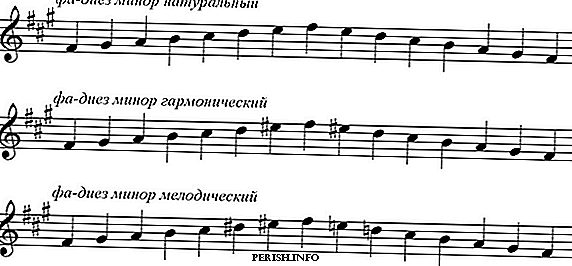
C sharp minor in three types. At the key we have four sharps. In harmonic form - B-sharp, in melodic - A-sharp and B-sharp in upward movement, and natural C-sharp minor in downward movement.
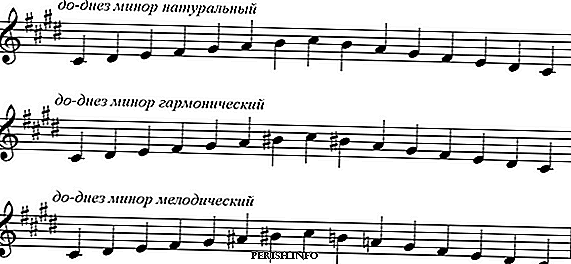
Key in minor. Key signs - flat in the amount of 4 pieces. In the harmonic fauna, the seventh step (m-bakar) rises, in the melodic one - the sixth (re-bakar) and seventh (m-bakar) rises, while moving downwards, the rises, of course, are canceled.
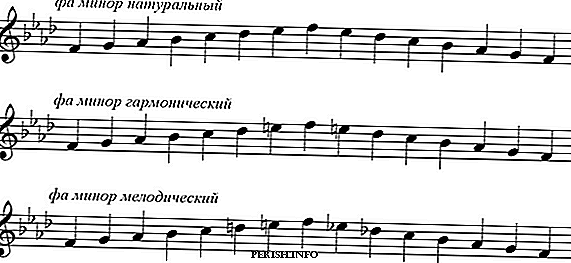
Three kinds to minor. Three key flatness at the key (si, mi and la). The seventh step in a harmonic form is increased (C-bakar), in a melodic form - except the seventh one is also increased by the sixth (a-bécar), in a downward movement of a scale of a melodic type, these rises are canceled and return in natural form.
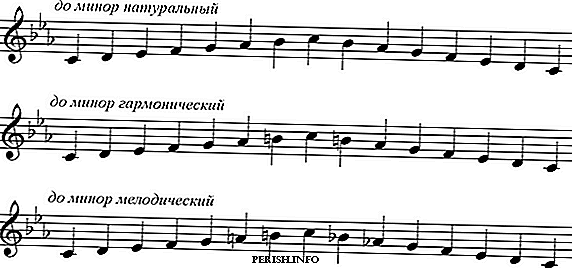
Key G minor: here two keys are set at the key. In harmonic salt, the minor is fa-sharp, in melodic - except fa-sharp, also mi-bakar (raising of the 6th step), when moving downward in the melodic salt minor - the signs of natural minor (i.e., fa-bakr and mi -emole).
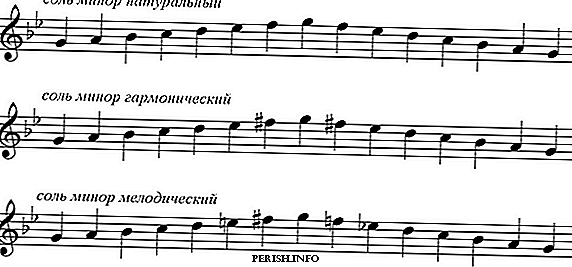
D minor in their three types. Natural without any additional alteration (do not forget only about the B-flat sign at the key). Harmonic D minor - with a raised seventh (C sharp). Melodic D minor - with upward movement of the C-bakar gamma and C-sharp (elevated sixth and seventh step), with a downward movement - the return of a natural look (B-bak and B-flat).
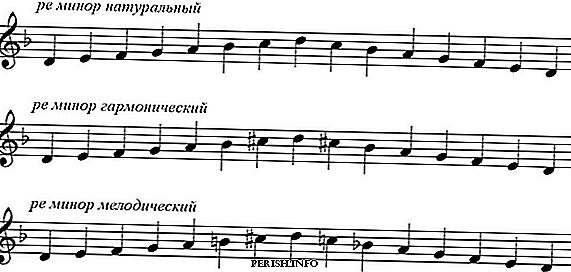
Well, on this and stop. You can add a page with these examples to the bookmarks (it will certainly come in handy). I also recommend to subscribe to the updates of the page of the site in contact in order to be aware of all the updates and quickly find the necessary material.

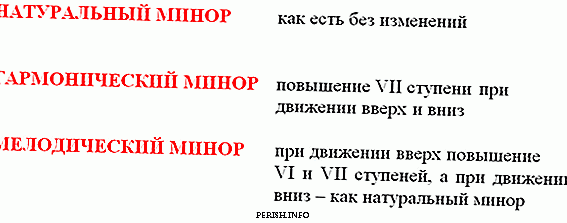
Leave Your Comment